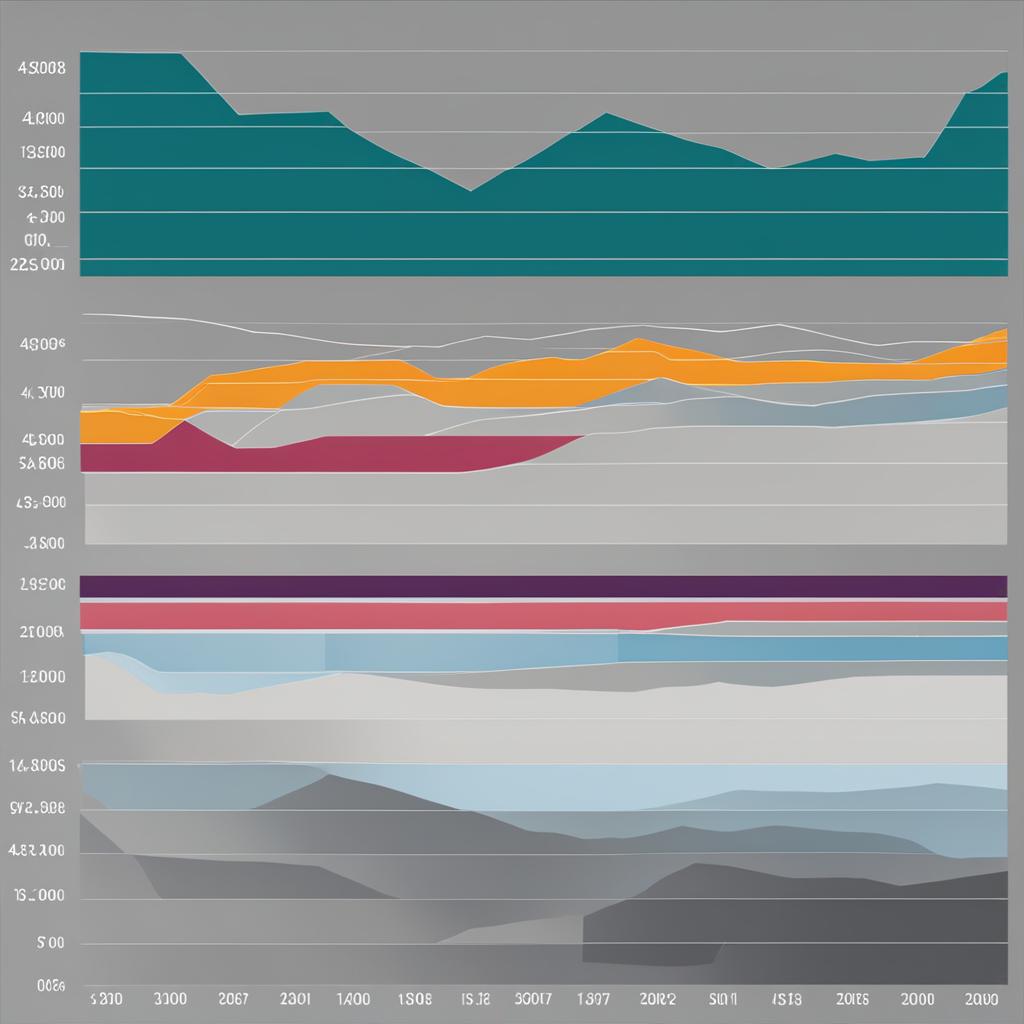The time value of money (TVM) is a fundamental concept in finance that I find fascinating. It states that a sum of money is worth more in the present than the same sum will be in the future. This is because money has the potential to generate earnings over time. TVM is crucial for making informed financial decisions, whether it’s investing in stocks, buying a house, or saving for retirement.
Understanding TVM involves calculating the future value and present value of money using formulas such as the present value formula and future value formula. These formulas consider interest rates, compounding periods, and time frames to determine the value of money at different points in time. TVM also encompasses concepts like compounding, discounting, annuity, perpetuity, net present value, internal rate of return, and cash flow analysis, all of which play a significant role in financial planning and decision making.
Key Takeaways:
- The time value of money is the concept that money in hand today is worth more than the same amount in the future.
- Understanding TVM is crucial for making informed financial decisions, such as investments and loans.
- Calculating the future value and present value of money involves using formulas that consider interest rates, compounding periods, and time frames.
- TVM plays a crucial role in financial planning, risk management, and assessing the value of investments.
- By understanding TVM, individuals can make sound financial decisions and work towards achieving their financial goals.
What is the Time Value of Money?
The time value of money, also known as the present discounted value, is a fundamental concept in finance. It refers to the concept that money in hand today is worth more than the same amount in the future. This is because money has the potential to be invested and earn returns over time.
Understanding the time value of money is crucial for evaluating the impact of interest rates, compounding, and inflation on the value of money. By considering the present discounted value, individuals can make informed financial decisions and maximize the potential growth of their wealth.
The time value of money can be explained through the example of investing $1,000 today versus investing the same amount a year from now. If the money is invested today and earns a 5% return, it will be worth $1,050 at the end of the year. However, if the same amount is invested a year from now, it will only earn returns for a shorter period and will be worth less than $1,050.
“The time value of money is a fundamental concept that recognizes the earning potential of money over time. It emphasizes the importance of considering the value of money in different time periods and guides individuals in making financial decisions.”
By understanding the time value of money and using appropriate formulas, such as the present value and future value formulas, individuals can calculate and assess the value of money at different points in time. This knowledge is essential for financial planning, investments, and evaluating the profitability and risks associated with various financial opportunities.
| Key Concepts | Explanation |
|---|---|
| Present Value | The value of a future sum of money in present-day dollars, considering the interest rate, compounding periods, and time. |
| Future Value | The value of an investment or sum of money at a future date, taking into account the interest rate, compounding periods, and time. |
| Interest Rate | The rate at which money grows or accumulates over time through investments or loans. |
| Compounding | The process of reinvesting earnings or interest on an investment to generate additional earnings over time. |
The time value of money is a fundamental concept in finance that guides individuals in making informed financial decisions. By understanding the present discounted value and utilizing relevant formulas, individuals can evaluate the potential returns and risks associated with different financial opportunities. This knowledge is crucial for maximizing wealth, achieving financial goals, and securing a stable financial future.
Why is the Time Value of Money Important?
The time value of money plays a crucial role in shaping our investment decisions, financial planning, and risk management strategies. As individuals, we strive to make informed choices that not only maximize our wealth but also secure our financial future. This is where the concept of the time value of money comes into play.
By understanding the time value of money, I can assess the potential returns and risks associated with different investment opportunities. This knowledge empowers me to make smart investment decisions and capitalize on the growth potential of my funds. Whether I’m considering stocks, bonds, real estate, or other asset classes, the time value of money helps me evaluate the projected growth and make calculated investment choices.
Moreover, the time value of money is instrumental in financial planning. I can craft a comprehensive plan for my future by considering the impact of the time value of money on my retirement savings, budgeting, and financial goals. By incorporating this concept, I ensure that my financial roadmap aligns with my long-term aspirations.
Risk management is another area where the time value of money proves its significance. Understanding this concept allows me to assess the potential risks associated with different investment opportunities, enabling me to make informed decisions that protect my capital and maximize my returns.
Knowledge of the time value of money is like a compass that guides me on my financial journey, helping me navigate the complex landscape of investment decisions, financial planning, and risk management.
Overall, the time value of money serves as a critical tool in making optimal financial decisions. By recognizing the importance of this concept, I can effectively plan for my future, safeguard my investments, and work towards maximizing my wealth and achieving my financial goals.

How to Calculate the Time Value of Money?
In order to calculate the time value of money, there are two key formulas that can be used: the future value formula and the present value formula.
Future Value Formula
The future value formula is used to determine the value of an investment or sum of money at a future date. It takes into account factors such as the interest rate, compounding periods, and number of years. The formula for calculating the future value is:
Future Value = Present Value x (1 + Interest Rate)^Number of Years
Present Value Formula
The present value formula, on the other hand, calculates the value of a future sum of money in present-day dollars. It considers the interest rate, compounding periods, and number of years. The formula for calculating the present value is:
Present Value = Future Value / (1 + Interest Rate)^Number of Years
These formulas are essential tools for making financial projections and assessing the value of investments. By using these formulas, individuals can determine the future or present value of an investment and make informed decisions based on their financial goals.
Calculating the time value of money is crucial for understanding the potential growth of investments and making sound financial decisions. By applying the future value formula and the present value formula, individuals can evaluate the value of their investments over time and make informed choices based on their financial objectives.
Examples of Time Value of Money
To better understand the concept of time value of money (TVM), let’s explore a practical example:
Suppose I have $10,000 that I want to invest for one year, and the interest rate is 10% compounded annually. Using the future value formula, I can calculate the future value of this investment.
The future value formula is:
Future Value = Present Value × (1 + Interest Rate)Number of Periods
Applying this formula, the future value of my $10,000 investment would be:
Future Value = $10,000 × (1 + 0.10)1 = $11,000
After one year, my investment would grow to $11,000 due to the compounding interest. This example demonstrates how the time value of money can impact the growth of investments.
Alternatively, we can also calculate the present value of a future sum of money using the present value formula:
Present Value = Future Value ÷ (1 + Interest Rate)Number of Periods
Let’s say we have a future value of $11,000 that we want to calculate the present value for, considering the same interest rate and time period:
Present Value = $11,000 ÷ (1 + 0.10)1 = $10,000
As demonstrated in these examples, the time value of money can be calculated both for determining the future value of an investment and the present-day value of a future sum of money. These calculations take into account the compounding effect of interest rates over time and are crucial for making informed financial decisions.
| Initial Investment | Interest Rate | Compounding Period | Number of Years | Future Value |
|---|---|---|---|---|
| $10,000 | 10% | Annually | 1 | $11,000 |
Effect of Compounding Periods on Future Value
The number of compounding periods in a year can greatly impact the future value of an investment. Let’s take the previous example of a $10,000 investment with a 10% interest rate. By increasing the number of compounding periods, such as to quarterly, monthly, or even daily, the future value calculations will result in higher amounts.
Why does this happen? Well, the more frequent the compounding, the more interest is earned on the principal. Let’s take a closer look at the effect of different compounding periods on the future value:
| Compounding Periods | Future Value |
|---|---|
| Annually | $11,000 |
| Quarterly | $11,038.70 |
| Monthly | $11,047.13 |
| Daily | $11,051.27 |
As you can see, the higher the frequency of compounding, the higher the future value. This highlights the importance of considering the compounding periods when calculating the future value of an investment. It also demonstrates the power of compounding in accelerating the growth of your investment.

Understanding the Importance of Compounding Periods
When it comes to investing, understanding the impact of compounding periods is crucial. The choice of compounding frequency can significantly affect the growth of your investments over time. By choosing a higher compounding frequency, you can potentially earn more interest and achieve greater wealth accumulation.
However, it’s important to note that the choice of compounding frequency may also depend on other factors such as the availability of investment options and the associated fees. You should consider these factors alongside the potential benefits of higher compounding frequencies.
In conclusion, the number of compounding periods in a year plays a vital role in determining the future value of an investment. By carefully considering the compounding frequency and leveraging the power of compounding, you can maximize your investment growth and reach your financial goals more efficiently.
How Does the Time Value of Money Relate to Opportunity Cost?
The time value of money is closely intertwined with the concept of opportunity cost. When making financial decisions, opportunity cost refers to the value of the best alternative that is forgone. In the context of time value of money (TVM), delaying an investment means sacrificing the opportunity for wealth growth.
Let’s imagine a scenario where I have a sum of money to invest today. By investing it now, I have the potential to earn returns over time. However, if I choose to delay the investment, I am essentially giving up the opportunity to generate those returns and potentially missing out on significant growth.
Understanding opportunity cost is essential for making optimal financial decisions. It allows me to weigh the potential benefits and drawbacks of different investment opportunities. By considering the time value of money, I can evaluate the potential returns and risks associated with each option.
“The cost of a decision lies not only in what you gain, but also in what you give up.”
By recognizing that delayed investments represent missed opportunities for growth, I can make more informed choices. Investing money today provides the chance to benefit from compounding returns and potentially achieve greater wealth accumulation over time.
Table: Comparing Investment Opportunities
| Investment Option | Annual Return | Initial Investment Amount | Opportunity Cost |
|---|---|---|---|
| Option A | 8% | $10,000 | $1,000 |
| Option B | 12% | $10,000 | $1,200 |
In the table, we can see a comparison of two investment options. Option A offers an annual return of 8% on a $10,000 initial investment, while Option B provides a 12% return on the same amount. By choosing Option A, the opportunity cost is $1,000, as I am forgoing the opportunity to earn an additional $1,000 with Option B. Understanding the concept of opportunity cost helps me make a more informed decision based on my financial goals and risk tolerance.

Recognizing the relationship between the time value of money and opportunity cost is crucial for maximizing wealth and making optimal financial decisions. By considering the potential returns and risks associated with different investment opportunities, I can choose the path that aligns with my financial goals and risk tolerance.
How is the Time Value of Money Used in Finance?
The time value of money (TVM) is a fundamental concept used extensively in various areas of finance. It serves as the foundation for conducting discounted cash flow (DCF) analysis, a widely utilized method for evaluating investment opportunities. By incorporating TVM, financial professionals can determine the present value of future cash flows, allowing for informed decision making.
Financial planning heavily relies on the principles of TVM. By considering the time value of money, individuals can strategize and ensure they have sufficient funds to meet their financial goals, such as retirement or purchasing a home. TVM helps in calculating the future value of investments, thereby aiding in planning for long-term financial security.
The time value of money is a critical aspect of risk management in finance.”
Risk management is another area where TVM plays a significant role. By assessing the potential returns and risks associated with different investment options, financial professionals can make well-informed decisions. Understanding the time value of money helps in determining the appropriate risk tolerance and selecting investments that align with an individual’s financial goals.
Benefits of Using the Time Value of Money
Utilizing TVM in financial analysis offers several key benefits:
- Accurate evaluation of investment opportunities
- Informed financial planning for long-term goals
- Risk assessment and mitigation strategies
- Decision making based on realistic future cash flow projections
To illustrate the application of TVM in finance, let’s consider an example:
Suppose an investor is considering two different projects with varying cash flow patterns and investment periods. By conducting a discounted cash flow analysis, the investor can calculate the net present value (NPV) of each project to determine which one offers the highest value. This analysis takes into account the time value of money, enabling the investor to make an informed decision based on the projected cash flows and their present value.

| Project | Initial Investment | Projected Cash Flows | Discount Rate | Net Present Value (NPV) |
|---|---|---|---|---|
| Project A | $100,000 | $30,000, $40,000, $50,000 | 8% | $100,000 |
| Project B | $150,000 | $20,000, $60,000, $90,000 | 8% | $70,000 |
In this example, Project A has a higher NPV of $100,000 compared to Project B’s NPV of $70,000. Therefore, based on the principles of TVM, Project A would be considered the better investment choice.
Incorporating TVM for Informed Financial Decision Making
The time value of money serves as a guiding principle in finance, allowing individuals and organizations to make informed decisions regarding investments, financial planning, and risk management. By understanding the impact of TVM, financial professionals can accurately evaluate investment opportunities, plan for long-term financial goals, and mitigate risks. Incorporating TVM within financial analysis helps in creating realistic cash flow projections and making sound financial decisions that align with desired outcomes.
What Impact Does Inflation Have on the Time Value of Money?
Inflation has a negative impact on the time value of money. When prices of goods and services rise over time, the purchasing power of money decreases. This means that the same amount of money will be able to buy fewer goods and services in the future compared to the present. Inflation erodes the value of money and reduces its future buying power, which is a key consideration when evaluating the time value of money.
Let’s dive deeper into how inflation affects the time value of money. Imagine you have $100 today, and the inflation rate is 2% annually. That means the value of your $100 will decrease by 2% each year due to inflation. So, after one year, your $100 will have the purchasing power equivalent to $98 in today’s dollars.
This erosion of purchasing power can have a significant impact on financial decisions. For example, when planning for retirement, it’s important to account for the effects of inflation on future expenses. If you only consider the present value of money without factoring in inflation, you may underestimate the amount needed to maintain your standard of living.
To illustrate the impact of inflation on the time value of money, let’s consider an example. Suppose you have $10,000 to invest in a high-interest savings account. The annual interest rate is 4%, but the inflation rate is 2%. Using a simple compounding formula, you would expect to earn $400 in interest over one year. However, because of inflation, the real return is only $200 ($400 – $200 due to the decrease in purchasing power).
“Inflation is the invisible force that eats away at the value of money over time. It’s important to consider the impact of inflation when evaluating the time value of money and making financial decisions.”
Understanding the impact of inflation on the time value of money is crucial for making informed financial decisions. It highlights the need to consider the erosion of purchasing power over time and adjust future values accordingly. By factoring in inflation, individuals can make more accurate projections, plan for future expenses, and protect the value of their money.
The Impact of Inflation on the Time Value of Money
| Year | Starting Amount | Interest Rate | Inflation Rate | Ending Amount (Nominal) | Ending Amount (Real) |
|---|---|---|---|---|---|
| 1 | $10,000 | 4% | 2% | $10,400 | $10,200 |
| 2 | $10,400 | 4% | 2% | $10,816 | $10,412.80 |
| 3 | $10,816 | 4% | 2% | $11,248.64 | $10,623.02 |
The table above demonstrates the impact of inflation on the time value of money over a three-year period. As the years go by, the nominal ending amount (including interest) increases, but the real ending amount (adjusted for inflation) decreases. This highlights the importance of considering inflation when evaluating the true value of money over time.
As shown, inflation can significantly erode the future value of money and diminish purchasing power. Therefore, it is essential to consider inflation when calculating the time value of money and making financial decisions. By factoring in inflation, individuals can ensure their financial plans account for the rising cost of goods and services and protect the value of their wealth in the long run.
The Bottom Line: Using TVM to Make Informed Decisions
The time value of money is a fundamental concept that can help individuals make sound financial decisions. By understanding time value of money (TVM) and using the appropriate formulas, individuals can evaluate the potential returns and risks associated with different investments. Whether you’re planning for retirement, budgeting for expenses, or considering investment opportunities, TVM can guide your decision-making process.
“Understanding the time value of money is crucial for making informed financial decisions and maximizing wealth. By taking into account elements such as interest rates, compounding periods, and inflation, you can assess the value of money over time and make strategic choices that align with your financial goals.
Calculating the Value
Using TVM, you can calculate the future value of an investment or the present value of a future sum of money. These calculations take into account factors such as interest rates, compounding periods, and time frames. By understanding these calculations, you can assess the growth potential of your investments and make informed decisions about where to allocate your funds.
Let’s consider an example: Imagine you have $10,000 to invest for one year with an interest rate of 10% compounded annually. Using the future value formula, you can determine that the future value of your investment would be $11,000. This calculation shows how TVM can impact the growth of your investments over time.
Budgeting and Financial Planning
TVM is not only relevant for investment decisions but also for budgeting and financial planning. By considering the time value of money, you can evaluate the implications of different financial choices on your long-term goals. TVM can guide you in deciding how much to save, when to start saving, and the impact of inflation on your purchasing power.
Maximizing Wealth
Using TVM allows you to make strategic financial decisions that can help maximize your wealth. By considering factors such as interest rates, compounding, and inflation, you can assess the true value of your money over time. This enables you to identify investment opportunities with higher potential returns and make informed choices that align with your financial goals.
In conclusion, understanding the time value of money is essential for making informed financial decisions. By recognizing the impact of TVM on investments, budgeting, and financial planning, you can navigate the complexities of personal finance and work towards achieving your financial goals.
TVM and Its Role in Investments and Wealth Maximization
Understanding the time value of money (TVM) is crucial for making informed investment decisions and maximizing wealth. By considering the TVM concept, I can assess the net present value (NPV) and internal rate of return (IRR) of different investment opportunities. These metrics help me determine the value and profitability of investments over time.
Net present value (NPV) is a financial calculation that takes into account the time value of money by discounting expected cash flows to their present values. By comparing the NPV of different investment options, I can evaluate potential returns and assess risks more effectively. A positive NPV indicates that the investment is expected to generate more value than the initial cost, making it a favorable choice.
Internal rate of return (IRR) is another essential metric to consider when evaluating investment opportunities. It represents the annualized rate of return that an investment is expected to generate. By comparing the IRR of different investments, I can assess their relative profitability. Generally, the higher the IRR, the more attractive the investment is.
Investing wisely and maximizing wealth require a deep understanding of the time value of money. By applying TVM principles, I can evaluate potential returns, assess risks, and make informed decisions that align with my financial goals.
Table: Comparing NPV and IRR of Investment Opportunities
| Investment Opportunity | Net Present Value (NPV) | Internal Rate of Return (IRR) |
|---|---|---|
| Option A | $10,000 | 8% |
| Option B | $15,000 | 10% |
| Option C | $7,000 | 6% |
This table compares the NPV and IRR of three investment opportunities. Based on the information provided, Option B has the highest NPV and IRR, indicating that it may be the most financially lucrative choice. However, it is essential to consider other factors such as risk tolerance and investment objectives before making a final decision.
Applying TVM Principles for Wealth Maximization
When it comes to wealth maximization, understanding TVM is key. By considering the time value of money, I can assess the potential returns and risks associated with different investment opportunities. This allows me to make informed decisions that align with my financial goals and help me achieve long-term wealth growth.
Furthermore, by integrating TVM concepts into financial planning and analyzing investments using metrics like NPV and IRR, I can optimize my wealth accumulation strategies. By focusing on investments with positive NPV and attractive IRR, I have a greater chance of maximizing my wealth over time.
The Power of Cash Flow Analysis and TVM
Cash flow analysis is an essential tool that incorporates the concept of time value of money (TVM). By analyzing the inflows and outflows of cash over a specific time period, individuals can gain insights into the present and future value of their investments. Cash flow analysis takes into account various factors such as the timing and magnitude of cash flows, discount rates, and the TVM concept itself.
With cash flow analysis, individuals can evaluate the profitability and viability of different financial decisions, including investments, loans, and business ventures. By understanding the relationship between cash flows and TVM, individuals can make informed financial decisions and maximize their returns.
How Cash Flow Analysis Works
Cash flow analysis involves examining the timing and amount of cash inflows and outflows associated with a particular investment or financial decision. These cash flows can include income, expenses, loan repayments, and other financial transactions.
By calculating and discounting each cash flow based on TVM principles, the analysis provides a more accurate representation of the present and future value of the investment. This allows individuals to make better-informed decisions about whether an investment is worthwhile or if alternative options may yield higher returns.
Benefits of Cash Flow Analysis
1. Identifying investment opportunities: Cash flow analysis helps individuals identify investment opportunities that align with their financial goals. By carefully examining the expected cash inflows and outflows, individuals can assess the potential returns and risks associated with different investments.
2. Evaluating profitability: Cash flow analysis enables individuals to evaluate the profitability of a particular investment or business venture. By considering the TVM concept, individuals can discount future cash flows to their present value and assess whether the investment is expected to generate a positive net cash flow.
3. Assessing financial feasibility: Cash flow analysis helps individuals determine the financial feasibility of a project or investment. By considering the timing and magnitude of cash inflows and outflows, individuals can assess whether they will have sufficient cash flow to meet their financial obligations and sustain the investment over time.
Cash Flow Analysis Example
Let’s consider an example to illustrate the power of cash flow analysis in conjunction with TVM. Suppose you are considering investing in a business project that requires an initial investment of $50,000. Based on projected cash inflows and outflows, the following cash flow analysis is generated:
| Cash Flow | Year 1 | Year 2 | Year 3 |
|---|---|---|---|
| Initial Investment | ($50,000) | ||
| Cash Inflows | $20,000 | $30,000 | $40,000 |
| Cash Outflows | ($10,000) | ($15,000) | ($20,000) |
| Net Cash Flow | $10,000 | $15,000 | $20,000 |
In this example, by discounting the future cash flows to their present value using TVM principles, you can assess whether the investment is financially viable. Cash flow analysis allows you to evaluate the profitability and potential returns of the investment and make an informed decision.
“Cash flow analysis is a powerful tool that combines the understanding of TVM with the evaluation of cash inflows and outflows. It helps individuals assess the profitability, financial feasibility, and potential returns associated with different financial decisions.”
By understanding cash flow analysis in conjunction with TVM, individuals can make optimal financial decisions that align with their goals and maximize their financial success. Whether it’s assessing an investment opportunity, evaluating the profitability of a project, or making budgeting decisions, cash flow analysis provides valuable insights into the financial implications of various decisions.
Conclusion
The concept of the time value of money is crucial in finance and has a significant impact on both personal and professional financial decisions. By understanding the principles of TVM and utilizing the appropriate formulas, individuals can evaluate the value of money over time, make informed investment decisions, and work towards maximizing their wealth.
Financial planning and risk management heavily rely on the time value of money. By considering TVM, individuals can assess the potential returns and risks associated with different financial opportunities, ensuring they make sound financial decisions. Whether it’s evaluating retirement savings, calculating loan payments, or assessing the value of annuities, TVM is an essential tool for wealth maximization and achieving financial goals.
Applying TVM principles helps individuals in making optimal financial decisions. By understanding how the value of money changes over time and using the appropriate formulas, individuals can navigate the complex world of investments, budgeting, and financial planning. This knowledge empowers individuals to make informed decisions, take advantage of financial opportunities, and work towards long-term financial success.
FAQ
What are some examples of the time value of money?
Examples of the time value of money include calculating the future value and present value of investments, assessing the value of annuities and perpetuities, and analyzing net present value and internal rate of return.
What is the time value of money?
The time value of money is the concept that money in hand today is worth more than the same amount in the future, due to the potential for earning returns over time.
Why is the time value of money important?
The time value of money is important for making informed investment decisions, financial planning, and risk management. It helps evaluate potential returns, calculate loan payments, and assess the value of annuities and perpetuities.
How do you calculate the time value of money?
The time value of money can be calculated using formulas such as the future value formula and present value formula, which take into account factors like interest rates, compounding periods, and time frames.
Can you provide some examples of the time value of money?
Examples of the time value of money include investing ,000 for one year with a 10% interest rate, which would result in a future value of ,000. Increasing the number of compounding periods in a year also affects the future value of an investment.
How does the number of compounding periods impact the future value?
Increasing the number of compounding periods in a year leads to a higher future value of an investment. More frequent compounding allows for more interest to be earned on the principal amount.
How does the time value of money relate to opportunity cost?
The time value of money is closely related to opportunity cost, which refers to the value of the best alternative foregone. Delaying an investment represents a missed opportunity to grow wealth and earn returns over time.
How is the time value of money used in finance?
The time value of money is used in various areas of finance, including discounted cash flow analysis, financial planning, risk management, and evaluating investment opportunities.
What impact does inflation have on the time value of money?
Inflation erodes the value of money over time, reducing its future buying power. As prices increase, the purchasing power of money decreases, impacting the time value of money.
How can the time value of money help make informed financial decisions?
Understanding the time value of money allows individuals to evaluate potential returns and risks, make informed investment decisions, and work towards achieving their financial goals through budgeting, retirement planning, and more.
How does the time value of money relate to investments and wealth maximization?
The time value of money is used to assess the net present value and internal rate of return of different investment opportunities. It helps investors determine the value and profitability of investments, ultimately working towards wealth maximization.
What is the role of cash flow analysis in conjunction with the time value of money?
Cash flow analysis incorporates the time value of money and allows individuals to evaluate the present and future value of investments. It helps assess profitability and viability, aiding in making optimal financial decisions.
How can the time value of money be used to make informed decisions?
By understanding the time value of money and using appropriate formulas, individuals can evaluate the value of money over time, assess potential returns and risks, and make informed financial decisions that align with their goals.
Our Friends
- https://www.investopedia.com/terms/t/timevalueofmoney.asp
- https://www.businessinsider.com/personal-finance/time-value-of-money
- https://home.ubalt.edu/ntsbarsh/business-stat/otherapplets/CompoundCal.htm
Money posts:
 What Is Compound Interest? | Make Money Doing Nothing
What Is Compound Interest? | Make Money Doing Nothing
 What’s the Difference Between Financial Freedom and Financial Independence in 2024?
What’s the Difference Between Financial Freedom and Financial Independence in 2024?
 What is a Cash-Out Refinance? (2024)
What is a Cash-Out Refinance? (2024)
 What Are the Different Types of Financial Advisors? (2024)
What Are the Different Types of Financial Advisors? (2024)
 What is a Checking Account Buffer? (2024)
What is a Checking Account Buffer? (2024)
 Is Blitz Win Cash Legit? Review (2024)
Is Blitz Win Cash Legit? Review (2024)
 Net Worth By Age Stats (+10 Ways to Improve Your Worth!) (2024)
Net Worth By Age Stats (+10 Ways to Improve Your Worth!) (2024)
 Is Robinhood Gold Worth It? (What $5 per Month Gets You) (2024)
Is Robinhood Gold Worth It? (What $5 per Month Gets You) (2024)

